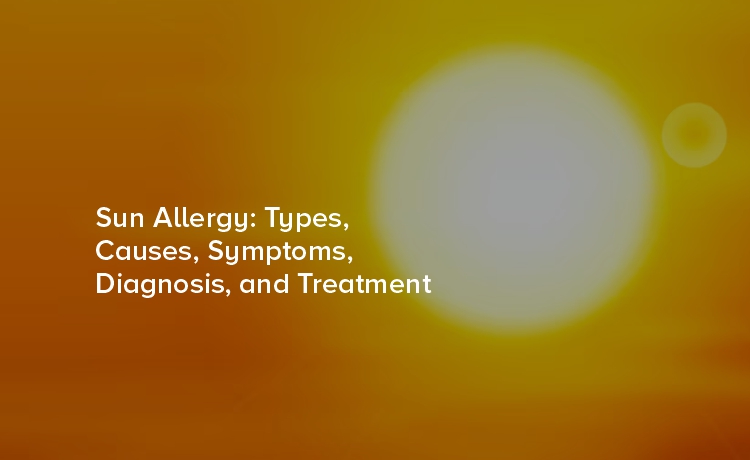
Sunshine is essential for life. It helps our body produce vitamin D, regulates our circadian rhythm, and boosts our mood. However, for some people, exposure to the sun can lead to an uncomfortable or even painful reaction. This condition, commonly known as sun allergy, can range from mild rashes to severe skin reactions, significantly affecting daily life. In this blog, we will explore the types, causes, symptoms, diagnosis, and treatments for sun allergy, helping you understand how to manage and prevent it effectively.
A sun allergy is an immune system response triggered by sun exposure. Unlike sunburn, which results from UV damage to skin cells, a photosensitivity skin reaction occurs when your immune system treats sun-altered skin as a foreign threat.
These reactions can develop suddenly, even if you've spent years in the sun without issues. The severity varies widely—some people experience mild discomfort, while others develop debilitating symptoms that limit outdoor activities.
Several distinct types of sun allergies exist, each with unique characteristics and triggers.
PMLE is the most common form of sun allergy, affecting approximately 10-15% of the population. It typically appears as an itchy rash on sun-exposed areas within hours or days of UV exposure. The condition often improves as summer progresses, a phenomenon called "hardening."
This hereditary condition primarily affects people of Native American descent. Actinic prurigo causes intensely itchy bumps and nodules on sun-exposed skin, often affecting the lips as well. Unlike PMLE, it persists year-round and can leave scarring.
Solar urticaria is a rare condition that causes hives within minutes of sun exposure. These raised, itchy welts typically fade quickly once you're out of the sun, usually within an hour or two.
This reaction occurs when UV light interacts with certain chemicals on or in your skin, such as sunscreen ingredients, fragrances, or medications. The immune system then reacts to this altered chemical structure, causing a rash that may spread beyond sun-exposed areas.
Sun allergies result from complex interactions between UV radiation and your immune system. Several factors can increase susceptibility.
Genetic predisposition plays a significant role. If family members have sun allergies, you're more likely to develop them too. Certain genetic variations affect how your skin responds to UV exposure.
Medications are a common culprit. Antibiotics, NSAIDs, diuretics, and some acne treatments can make skin more reactive to sunlight. Always discuss photosensitivity risks with your healthcare provider when starting new medications.
Chemical exposures from skincare products, fragrances, or even plants can sensitize skin to UV light. Lime juice and certain plants contain compounds that become reactive when exposed to sunlight, causing what's known as phytophotodermatitis.
Underlying conditions such as lupus, dermatomyositis, or porphyria can manifest with sun sensitivity as a primary symptom. If you develop new photosensitivity, a thorough medical evaluation is essential.
Symptoms of sun allergy can vary in severity, but common signs include:
Symptoms may appear within minutes, hours, or even days after sun exposure, depending on the type of sun allergy. Chronic exposure can lead to skin thickening and hyperpigmentation.
Proper diagnosis of sun allergy requires expertise and sometimes specialized testing. Your dermatologist will begin with a thorough history and physical examination, asking about:
Phototesting may be recommended to confirm the diagnosis and identify which wavelengths of light trigger your reaction. During this procedure, small areas of skin are exposed to controlled amounts of UV light to observe your response.
Photopatch testing helps identify photoallergic reactions by applying potential allergens to your skin, then exposing test areas to UV light. This distinguishes between chemical sensitivities and other types of sun allergies.
Blood tests and skin biopsies may be necessary to rule out underlying autoimmune conditions or other disorders that cause photosensitivity.
Treatment approaches depend on the type and severity of your sun allergy, but several effective options exist.
Corticosteroid creams reduce inflammation and itching during flare-ups. Your dermatologist will prescribe an appropriate strength based on symptom severity and affected areas. These should be used as directed, as prolonged use can thin the skin.
Calcineurin inhibitors offer an alternative to steroids for facial and sensitive areas. These medications suppress the local immune response without the side effects associated with long-term steroid use.
Antihistamines help control itching and can prevent reactions when taken before sun exposure. Non-drowsy formulations allow you to stay alert while managing symptoms.
Antimalarial drugs like hydroxychloroquine prove effective for severe PMLE and photodermatoses associated with autoimmune conditions. These require regular monitoring but can provide substantial relief.
Short courses of oral corticosteroids may be necessary for severe reactions, though they're not suitable for long-term management due to potential side effects.
Controlled exposure to UV light under medical supervision can help build tolerance in some people with PMLE. This "hardening" treatment typically begins in late winter or early spring, preparing your skin for summer sun.
Prevention remains the cornerstone of sun allergy management. Implement these protective measures:
Sun avoidance during peak hours (10 AM to 4 PM) significantly reduces exposure to triggering UV radiation.
Broad-spectrum sunscreen with SPF 30 or higher should be applied generously and reapplied every two hours. Choose physical blockers containing zinc oxide or titanium dioxide if you have photoallergic reactions to chemical sunscreens.
Protective clothing including long sleeves, wide-brimmed hats, and UV-blocking sunglasses creates a physical barrier. Many clothing brands now offer UPF-rated fabrics specifically designed for sun protection.
Medication review with your healthcare provider ensures you're aware of photosensitizing drugs you may be taking and can explore alternatives if necessary.
Sun allergy is a common but often misunderstood condition that can significantly impact quality of life. From mild rashes to severe photosensitivity skin reactions, symptoms vary widely, but with proper care, most cases can be managed effectively. Understanding the types, causes, and symptoms is crucial for early diagnosis, while preventive measures and appropriate sun allergy treatment can help you enjoy the sun safely. Always consult a dermatologist for persistent or severe reactions and take proactive steps to protect your skin from harmful UV exposure.